What if talking on a cell phone behind the wheel isn’t so dangerous after all?
What if people who are on the phone naturally tend to drive more carefully, essentially canceling out any danger?
That’s the startling implication of a cleverly designed study released Thursday that hasn’t yet gotten much attention in the media. Its authors, a professor of social and decision sciences and an economist, readily admit that their findings seem contrary to some (though not all) previous work in the area.
But if there are obvious flaws in this fascinating bit of research on a question that matters to everyone on the road, I don’t see them — and we’d love to give BikePortland readers the first chance to find them.
The authors, Saurabh Bhargava of Carnegie Mellon University and Vikram S. Pathania of the London School of Economics, start their paper with a big puzzle: If talking on a cell phone is as distracting as being drunk, and cell phone use has been increasing rapidly for 30 years, why have U.S. highways been getting so much safer?
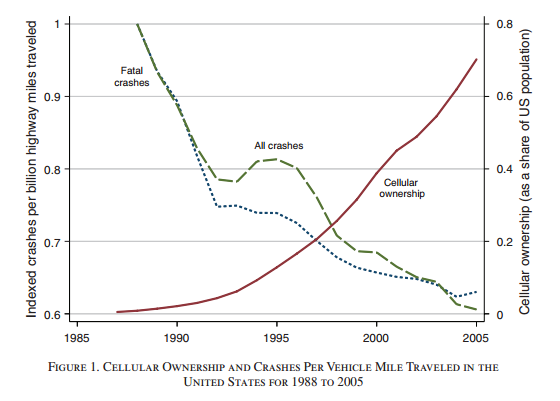
rapidly rarer, though cell phone use is increasing.
(Images by Bhargava and Pathania)
Today, the authors write, the average cell phone user talks for 740 minutes a month, and surveys show that “as many as 81 percent of cellular owners use their phones while driving.” If the most influential previous study on this subject is right, this ought to be a disaster for U.S. roads.
That influential study, a 1997 paper that examined the phone bills of Canadians involved in car crashes, concluded that people in cars are 4.3 times more likely to crash while using their phones. That research, plus the common intuition (mine included) that talking on a phone is distracting, has helped lead 37 states (including Oregon) to forbid or restrict the practice.
Bhargava and Pathania raise several problems with the 1997 study, one of which is that its authors may not have accounted properly for the chance that people are more likely to place calls immediately after a car crash. Then, they bring out their most interesting insight: from 2002 to 2005, there was a big spike in cell phone usage every weeknight at 9 p.m., when millions of Americans switched to nights-and-weekends minutes.
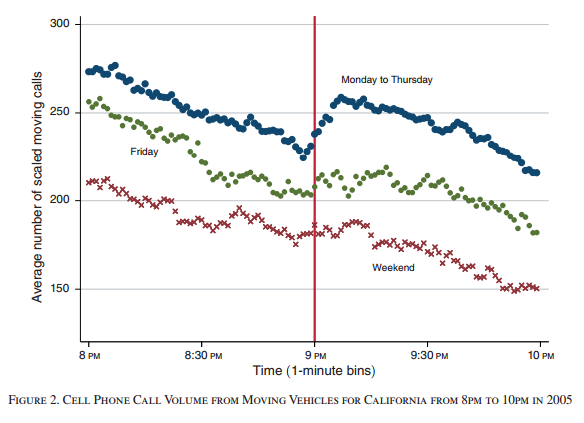
by 7 percent right after 9 p.m. on weeknights.
Even more impressive, the authors convinced an unnamed cell phone company — a source that, it’s worth noting, isn’t exactly disinterested on this subject — to share data specifically from phones that were rapidly switching from one cell tower to another, so fast that they must have been in a moving vehicle. That’s the data in the chart just above.
If cell use greatly increases the chance of a crash, the authors conclude, you’d expect crash rates to spike at 9 p.m, too. But they didn’t:
The authors write that they don’t think hands-free phones were an issue: those were uncommon before 2005, and in any case research shows that they’re just as distracting as regular phones.
Instead of disputing the fact that talking on a cell phone tends to be distracting, Bhargava and Pathania suggest three theories:
“It is possible that drivers who use such devices compensate for the added distraction by driving more carefully. Alternatively, it could be that risk-loving drivers may treat cell phones as a substitute for other, equally debilitating, distractions. Finally, because we measure a local average treatment effect, it could be that cell phones are dangerous for certain drivers (or driving conditions) and are beneficial for others, or that our estimates reflect an unrepresentative time of day, mix of drivers, or composition of calls.”
It’s a provocative paper, no question. And it seems likely to get more attention in the media. What’s your take?

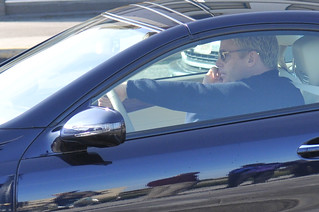
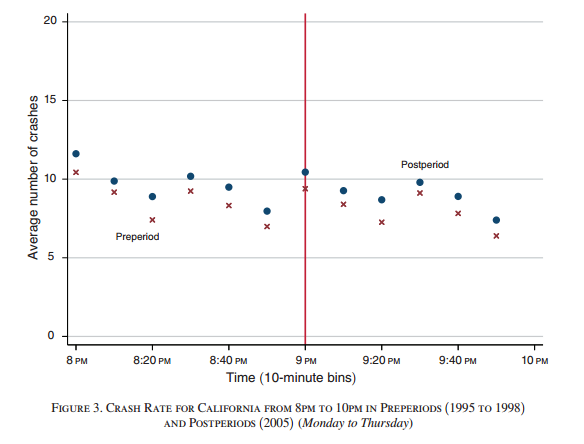
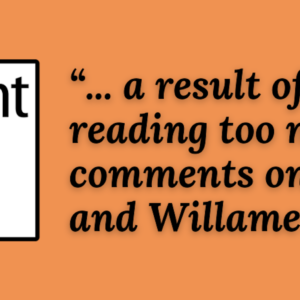


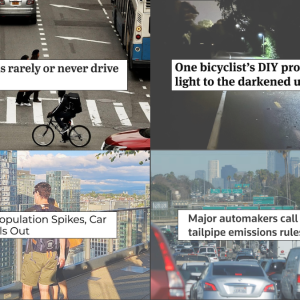
Thanks for reading.
BikePortland has served this community with independent community journalism since 2005. We rely on subscriptions from readers like you to survive. Your financial support is vital in keeping this valuable resource alive and well.
Please subscribe today to strengthen and expand our work.
Less people using the roads in the evening and after 9pm.
Roads and car are being designed more safe to prevent crashes.
It’ll be interesting to see what more and more connected technologies built into the car will bring. While I agree that the current trend of having a screen in the dashboard is indeed a distraction, voice-enabled technology on the other hand may reduce distractions. I’d certainly prefer to be around drivers asking their cars for spoken directions than drivers trying to read their iPhone’s GPS app (one BMW driver nearly took me out after an illegal unsignaled right turn on the way to a wedding last summer – the act of being lost is a cognitive distraction itself).
Also insurance companies currently offer connected devices that monitor driving habits and incentivize good behavior with reduced premiums. Current and future generations of cars already have this technology built in, though, and it may just be a matter of time before speed, acceleration, and braking data becomes just another ‘big data’ problem solved by insurance companies trying to mitigate their financial risks.
Whether we like it or not, there is a saying in the security world that “a surveilled society is a polite society.”
lol only “new” roads are designed more safe and theres a upper limit on stupidity that you can design for.. so the majority of the roads that people are driving on are “old” roads not newer “safer” roads
Thats exactly why i like to drive over the mountain passes at night.. is because i can just relax and drive and enjoy it.. rather than competing with a whole bunch of people who may or may not know how to drive right.
Exactly. In the last graph, the number of crashes stays flat, but it should be going down. To mean much it should present the crash rate – crashes per average vehicles on the road.
Take a closer look. I don’t think the comparison is whether it’s flat or not, but that it is relatively the same before and after the time period when evening cell phone usage spiked (preperiod and postperiod).
My point being the entire y-axis unit of measurement is flawed for the purpose of the graph, since it is not adjusted for average change in number of vehicles on the road. How can you really tell there is not a spike, when 9 pm also happens to be a time that average vehicle use is falling precipitously?
One wonders where these folks
http://www.distraction.gov/content/get-the-facts/facts-and-statistics.html
get their data?
Distracted driving is any activity that could divert a person’s attention away from the primary task of driving. All distractions endanger driver, passenger, and bystander safety. These types of distractions include:
Texting
Using a cell phone or smartphone
Eating and drinking
Talking to passengers
Grooming
Reading, including maps
Using a navigation system
Watching a video
Adjusting a radio, CD player, or MP3 player
But, because text messaging requires visual, manual, and cognitive attention from the driver, it is by far the most alarming distraction.
. . . . . .
At any given daylight moment across America, approximately 660,000 drivers are using cell phones or manipulating electronic devices while driving, a number that has held steady since 2010. (NOPUS)
maybe there is less grooming and eating and more talking?
1: Please pick out new sexy car/cell model for this topic. I think I hate that guy in the photo above. Real, real tired of seeing his face…
2: Ahhh(bullshit)ccchhhoooo! excuse me.
and
3: Saurabh Bhargava of Carnegie Mellon..former employee of and more than likely having research funded by this fine telecommunications advisory firm..
http://www.mckinsey.com/global_locations/north_america/minneapolis
Have a nice day everyone.
Wow, interesting about Bhargava. There it is in plain Google-able black and white–or blue, or whatever. I don’t know for sure that prior employment by a large telecommunications consulting firm casts doubt on his research methods at a major university, but it’s certainly suggestive, isn’t it? Especially when the study’s findings contradict those of a whole lot of other studies. Hmmm…
That is my first thought without digging into the numbers. Do we have good data on distracted driving other than cell phones? I know I’ve seen people reading books, and doing paper work, and playing with radios and certainly eating, and I often drink coffee while driving on the freeway myself. Also, it is often mentioned here that kids can be a distraction and I know that certain types of conversation with a passenger are a distraction for me (some types of conversations are distracting, others are not or are much less so).
So maybe to at least some significant extent distracted cell phone driving is just replacing other distracted driving behaviour.
Let’s see the crash statistics during rush hour after work when people are tired and arguing with their spouses/children.
If you have no power steering and are driving a stick shift it is a pain in the rear
A timely study. Werner Herzog just released a 30 minute film aimed at teens about the dangers of texting and driving. It’s supposed to be shown in 40,000 high schools where it’s been sent out. You can watch it online. Very moving.
http://gawker.com/this-documentary-might-be-the-thing-that-kills-texting-1079853007?utm_campaign=socialflow_gawker_facebook&utm_source=gawker_facebook&utm_medium=socialflow
Thanks for that link.
Here’s AT&T’s site where this film is hosted: http://www.itcanwait.com/
I wonder how long until we get a campaign that collects pledges not just not to text and drive, but not to drive at all?
so much wrong here –
http://www.wsbt.com/news/wsbt-driver-in-fatal-buggy-crash-wont-be-charged-20130409,0,5593474.story
Texting while driving should be punishable like a DUI. What dumbass *reads* while driving down the highway?
The cellphone laws are hardly enforced now. Makes me wonder why the laws were put in place to begin with.
Cellphone users in car or on bikes have so little regard for anyone around them and this report will just make it worse.
…and cellphone walkers, too.
As an economist, color me skeptical. This is an interesting way of looking at the question but it doesn’t appear to answer the question. For one thing, the graphs are scaled in a way that makes the jump in calls at 9pm look bigger than the jump in crashes at 9pm (there is such a jump). If both graphs were scaled including zero on the y-axis, I think they’d look pretty similar around 9pm – though there is clearly more variation in the number of crashes than calls.
In a wider sense, one economics paper is not enough to base policy around. You need to get a couple well-regarded papers on the same topic agreeing before I have reasonable confidence that the data and methodology of the original authors were not anomalous or misleading for some reason not easily seen from the outside (e.g. Excel formula errors, which caused issues in a high-profile national debt paper used to justify policy in the last few years).
Right, but that jump at 9 is there back before cell phones were widely used — we have to assume it is caused by some other factor. This is an interesting and unexpected result — though I’d love to see it replicated with somebody else’s data.
It would be interesting to know if the crash statistics are an average for a full year, or were taken during a specific month. Sunset is around 9pm in July for most of the US, which could be a factor that is not accounted for in the study.
Also, I don’t see how they can infer that there isn’t a spike in crashes after 9pm … it sure looks like there is a spike between 8:50 and 9pm to me.
Horseshit, I refuse to believe it. What wireless company funded the study?
Lies, Damn lies and statistics. A trifecta of deception.
“Alternatively, it could be that risk-loving drivers may treat cell phones as a substitute for other, equally debilitating, distractions.”
So…people are deciding to talk on their phones in lieu of drunk driving? Impressive!
This study is also based on miles driven on US Highways which does not take into account other roads.
I thought that too, but it looked like in the article it was all road, they just refer to them as highways for some reason. Maybe I am reading it wrong, but that’s what I took away.
http://bikeportland.org/2011/07/06/bike-law-101-whos-on-the-roadway-55920
Well, good thing that this study has not been widely reported yet as it certainly appears to have several fundamental flaws. The major one being that any risk posed by cell phone use is overwhelmed by other risks faced on the road. That certainly does not mean, however, that cell phone use does not pose a risk.
Unlike drunk driving, the risk from talking while driving only lasts during the length of the call, which is typically short. As it takes hours to sober up, the risk of drunk driving lasts for the entire trip.
Using the numbers from the study, at 740 minutes per month, people are using cell phones for around 1.5 minutes for every waking hour, or 15 seconds for the 10 minute crash bins used in the study. From the graph, it looks cell usage climbs by about 15% just after 9, or a bit over 2 seconds of the 600 seconds in the 10 minutes. So, for that 2 seconds, the crash risk increases 4.3 times. Over the ten minutes, the increased crash risk is very small compared to the total crash risk likely way under the margin of error for the study.
However small the increased risk is, however, over a large population, a small increased risk can and often does result in hundreds of deaths and thousands of injuries.
The only meaningful and valid method to determine if and how risky driving while phoning is, would involve comparing crash rates of drivers calling verses drivers not calling. Studies like this are useless and the method can onl be called clever if the intent was to mislead.
“Unlike drunk driving, the risk from talking while driving only lasts during the length of the call, which is typically short. As it takes hours to sober up, the risk of drunk driving lasts for the entire trip.”
I think this is a very good point. The comparison probably works only with a bunch of qualifications. But driving without paying enough attention does seem to be a serious problem, at least according to the distraction.gov folks:
In 2011, 3,331 people were killed in crashes involving a distracted driver, compared to 3,267 in 2010. An additional, 387,000 people were injured in motor vehicle crashes involving a distracted driver, compared to 416,000 injured in 2010.
10% of injury crashes in 2011 were reported as distraction-affected crashes.
Have these deaths and injuries increased while those from other causes have continued to fall (even faster)? Would the total rates of injury and death per mile traveled have continued to fall at the pre-1993 rate without the rise of cell phones and related distractions?
I have one question and one hypothesis.
Question: what percentage of crashes are on highways?
hypothesis: It could be less risky to use cell phones while on a highway than to use them on other roads (highways tend to be divided, and while cars are moving faster they are moving in the same direction and there are no traffic intersections, so there are fewer interruptions/other things you need to pay attention to).
I’d be interested in comparing crashes on highways, city streets, and rural streets and to what extend cell phone use was a factor in each of those settings. only after looking into that data would you be able to reach any conclusion about cell phone and crash rates.
Thank you – I wondered if anyone would grab the “only on highways” distinction. I’m guessing it makes a substantial difference.
http://bikeportland.org/2011/07/06/bike-law-101-whos-on-the-roadway-55920
In Oregon, and I believe in most legal jurisdictions, “Highway” is defined roughly as “any public road”. Not to be confused with a limited-access freeway.
Correct. Highway is a public road generally built higher up than the surrounding landscape, a term created by federal authorities, and not the common term used by laypersons to describe high speed state or federal roadways.
Or, if people aren’t talking while driving, they’re doing other risky things like texting, yelling at the kids in the back seat, eating and/or drinking, playing the dog on their lap, etc.
This study was searching for an excuse to exculpate the dangers of cell phone use while driving.
Look at the graphs: cell phone use is shown on a scale of 0% to 65%, while crashes are shown on a scale of 600 to 1000 million, with no zero. This greatly exaggerates both changes, and it’s bad statistics.
Richard has already shown why there was no statistically significant increase at 9 pm:
“From the graph, it looks cell usage climbs by about 15% just after 9, or a bit over 2 seconds … in the 10 minutes. So, for that 2 seconds, the crash risk increases 4.3 times. Over the ten minutes, the increased crash risk is very small compared to the total crash risk – likely way under the margin of error for the study.”
This study doesn’t contradict the previous research. It’s exactly what one would expect to see.
This study wasn’t designed to find the risk of cell use, it was designed to white-wash it, for the benefit of the phone companies which supported this so-called “research.”
You could do a study just like this to make drunk driving look good. You could find some data about bar closing times (in a city where all bars close at midnight, for example), and show that there were 20% more drunk drivers in the hour after bars close versus before. Then, you would show that graph that shows a flat rate of crashes before and after midnight.
But of course, many of those crashes are in fact due to drunk driving, perhaps 25%. But 20% of 25 is only a 5% increase; too small to see in noisy statistics; the second chart shows random jumps of 10% up and down every 20 minutes!
Then you tell the news, “Our surprising study showed that drunk driving doesn’t lead to crashes. Perhaps drunks use cell phones less, or eat less, or talk to passengers less, or drive more carefully. We should reconsider restrictions on drinking and driving.” And you get a fat paycheck from AB InBev (Budweiser, etc).
I wonder if the increase in calls was matched by a decrease in texts? Perhaps once the calls were free, people called instead of texting…
This reminds me of when cigarettes had “no evidence of causing cancer”.
When my spouse and I were home shopping, the realtor drove us all over hell and back, and couldn’t stay off the phone, wheelin and dealin amd coordinating. I shooda bailed on her, because there were quite a few scary times involved riding with her. Wouldn’t do it again. Common sense says distracted driving is dangerous.
The best thing you could have done is told her: “We are going to take our business to a Realtor that cares about the safety of her clients and people in our community.”
Might have been a wakeup call.
I’m not sure the “highway” word is really limiting their crashes to only divided highways or similar — I skimmed the paper and saw phrases like “universe of crashes” and they talked as if they were counting all of them, not just those on interstate-like highways.
One explanation that they put forth, not mentioned in the summary, is that the phone calls made after 9pm are non-urgent, and may either be less attention-sucking, or more amenable to “hold on, traffic” pauses. One thing I did not see them consider was that the people who pay enough attention to price and time (and thus put off their cell phone calls till 9pm) might not be representative of drivers as a whole — they might be safer drivers.
The researchers show their bias by asking why crash rates continued to drop after cell phones became popular, instead of asking how the cell phones affected the trends in crash rates. Car crashes in the US have been declining for a long time (http://www-fars.nhtsa.dot.gov/Main/index.aspx), for a variety of reasons, and the more relevant question would be how cell phone usage has affected the trend of declining crashes. An even more interesting question would be why crashes in the US are not declining as rapidly as in Europe…
It doesn’t seem like the question over cell phone use needs a particularly clever research design anyway- some states still don’t monitor cell phone use at all, or they only control it for teenage drivers. It seems that you could compare rates between states that do ban cell phone use and enforce to states that don’t, controlling for differences in population, VMT, crash rates before cell phones, etc.
The trend was reversed in 2012 with a jump of over 4K deaths from 2011. I would put up a link but the 2012 data seems to have been removed from the web site since the last time I visited it. FL is still the most deadly place to walk or ride a bike though.
We can still narc on them though, yes? Those car driving bastards
@Michael Andersen (Contributor)
Next time, I’d really recommend running a study like this by some academics first to see what they have to say regarding the methods. Their methodology is just too complicated for most people to make any sense of at all.
It is clear that the charts though are meant to be misleading. They acknowledge in the study that the reported times of the crashes are not precise with many that occur a few minutes before or after the hour are reported on the hour. They do group the collisions into 10 minute bins as a result but they don’t do the same for the call times in the chart. If they tried harder to ensure both charts reflected the same time periods, graphically, the charts would not appear to as strongly support the conclusion as the cell calls drop dramatically in the few minutes before 9 and rise just after. The average increase in usage would be no where near as dramatic.
Ok that’s 2005, what about now, with increased cell phone ownership and in my part of the world, Australia, some behaviours are on the increase.
also, since 2005 the amount of miles driven has sharply declined…
Why isn’t there a spike at 9 pm? Maybe because if someone is in the middle of a car trip they’re not as likely to pick up their phone and make a call right at 9? We don’t know that those calls right at 9 are evenly distributed between people who are driving, people who are sitting at home on their couch, and people engaged in other activities. Maybe someone who was driving when the clock struck 9 was simply more likely to make their call after they finished their car trip.
Also I don’t see that they controlled for total number of drivers on the road. With each passing hour in the evening, fewer people are driving and more are home putting their kids to bed or just chilling out. By 9 a lot of destinations people drive to during the day aren’t even open anymore.
read article again please
“”data specifically from phones that were rapidly switching from one cell tower to another, so fast that they must have been in a moving vehicle. That’s the data in the chart just above.””
so you do know who is in a car or who is at home
I’m still wondering why I can’t recall such a large number of bus crashes in 2005. Was the number of fatal crashes really greater than the number of “all crashes”? Maybe its just incomplete data at the tail end of the first graph…
I don’t agree with it, so it must be all lies! It goes against my assumptions so the data is obviously doctored and manipulated! Further, I know Bhargava has used a cell phone and thus he is not to be trusted to give an unbiased report of his “findings”.
It is obviously an agenda put forth by the telecommunications industry (we all know they secretly make hundreds of millions more when the phone is being used by a person engaged in the act of driving).
ok – so just from the commute this morning i sat at a stop sign with a guy directly head at me. Even though he had the right of way to go straight (i was turning with my left hand held high to indicate my turn) he just sat there. I couldn’t see what was going on in the car cabin due to glare, so after waiting a requisite amount of time i figured he must have been checked out in some way.
Sure enough when i finally decided to make my turn in front of him, I saw he was looking around, phone to face, and deciding to turn right (no signal) or any eye contact at all to indicate he even realized i was there.
I guess i should just be happy in his checked out cellphone stupor that he didn’t understand what was required of him in what SHOULD have been his primary task – attention when driving???
The roads are FULL of cellphone zombies that are inattentive, impossible to predict, and unaware of anything other than the conversation they’re having in their own little world. How can that possibly be safe!?? What I wonder about from this study is how many accidents are CAUSED by those on their cellphones, but they don’t even realize that they’ve caused them because they are SO checked out that they are simply oblivious to it all?
Some points of skepticism:
I wish I had the statistics background required to understand why those graphs that look roughly the same shape to my eye (there is a jump in crashes at 9 p.m…) don’t correlate significantly.
Another questionable factor is asking a phone company for data to prove that phones are bad. Did they exclude, for example, customers whose last call ever was made after 9 p.m.? You can toss inconvenient data all day long, and a phone company doesn’t have any academic integrity concerns to prevent them doing so.
One of the researchers’ history working in the telecomm industry is interesting. The American Beverage Institute would also like you to know that it’s perfectly safe to drive with a BAC of 0.09…
I skimmed the study trying to understand their approach to crash data. (I have no doubt that cell calls increase at 9:00.) They seem to be comparing the difference between crashes just before 9 and crashes just after 9, before and after use of cell phones became prevalent.
This is a calculation of the form (A-B)-(C-D). Small differences in big numbers are hard to measure accurately.
The authors admit that their error bars allow the crash rate to be 3 times higher for drivers using a cell phone than not, but they say the ratio of 4.3 estimated in the previous paper is inconsistent with their data. But true errors in data of this sort are almost always higher than the errors estimated by statistical techniques, because there are systematic errors than are hard to quantify or even identify.
Moreover, authors with an agenda have a choice of datasets and statistical approaches, and can choose to publish the one with a result they like.
Given the marginal statistical significance of these results, and their inconsistency with other publications, they should be treated skeptically.
The flaw is that cars are becoming safer and that is not worked into the study. People are absent minded with their phones. With safer cars and increased traffic we don’t go as fast and are less likely to die when doing so.
I’d have to read the article to come to a thorough conclusion, but one item is sticking out at me already. Of the last two graphs, the one showing an increase in cell phone activity for people moving fast enough to be in a car is from 2005, when cell phone were fairly prevalent (although these calls also could have been placed by non-drivers (passengers) in a car, people on a train, etc.). The last graph is from years 1995 to 1998, when cell phones were not as ubiquitous (see 1st graph). In this case, it means nothing to say that we did not see an increase in crashes from 1995 to 1998, as according to graph 1 less than 1/4 of the US had cell phones for that period. Apples and oranges.
But even if we assume that crash rate held true into the future (which is not a valid assumption), there is still a slight bump at the 9 pm hour. There looks to be a lot of white noise in the data, but you can see a general trend from 8 to 9 pm that starts around 12 crashes/10 min to around 8. Then at 9pm we are boosted back up to 11 crashes/10 min, and it slowly winds down to roughly 7 by 10 pm. That’s a 38% increase in accident rate from 8:50 to 9:00. Conversely, the spike in cell phone use on those same days (mon-thur) goes from about 225 to 260, which is only a 16% increase. Put another way, even this flawed data is showing that a 16% increase in cell phone use while driving is resulting in a 38% increase in accidents.
It’s getting safer because drivers are getting really really good at driving safely.
I want a portable cell phone jammer I can have on my bike. Then people would be really distracted. Personally talking on the phone is not as bad as when they are trying to text or read their emails or twitter.
Not smart solution. What would be the result of a driver suddenly having to give all his attention to a malfunctioning cell just as he’s nearing you. Good luck.
A single study is not conclusive evidence.
I’d like to see meta-data from numerous studies.
Talking may or may not be a dangerous distraction depending on the driver and which task they choose as primary (i.e., do I tune out of part of the conversation because driving required more attention, or do I tune out of driving because my conversation is so compelling? Can I even decide which to do at any given moment?), but texting/emailing/looking at pictures/etc. would seem to be unequivocal dangers to other road users.
First iPhone introduced: June 29th, 2007–two years after the data for this study was collected.
Another, “I don’t like the results, so I choose not to believe” article.
It’s one study. there are many. An author of another scientific study was on NPR last week stating the opposite, and even showing that brain activity involved with simply having a conversation can be considered distracted driving based on brain scans.